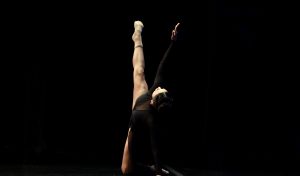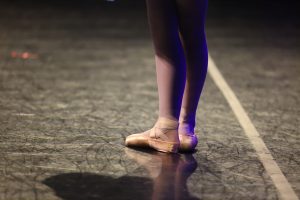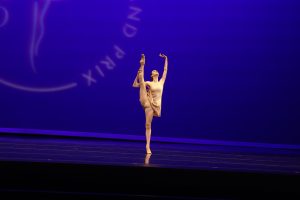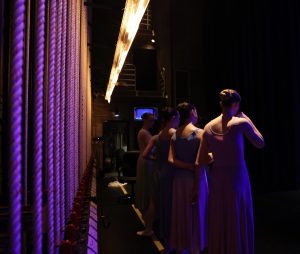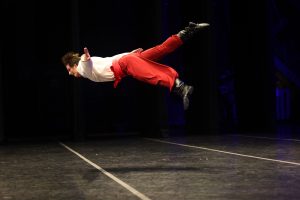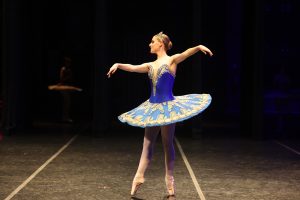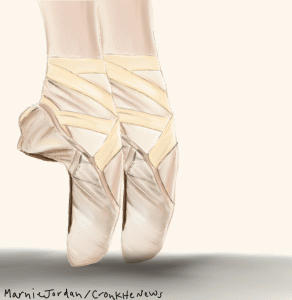- Slug: BC-CNS-Ballet Scholarships. 1,100 words. By Marnie Jordan.
- Photos available (thumbnails and captions below).
- GIF available below.
By Marnie Jordan
Cronkite News
PHOENIX – Dancers nervously wait backstage to perform in front of judges who may determine the fate of their careers. Once a performer’s number and name are called, they elegantly walk on stage under dramatic stage lights as they prepare to start their routine.
In the darkness of the auditorium, the audience, the judges sit and wait.
“It feels like my skin is on fire and has ants all over it,” says 17-year-old performer Alicia Lucchesi. “And then I get on stage and it’s still there, but the second I start moving, it’s like it disappears. I come off and it feels like I’ve taken the first breath after a million years of not breathing.”
As Lucchesi’s music begins, she rises on her toes and performs a solo from “La Esmeralda.” Her striking red costume billows as she turns and leaps through the classical ballet.
Lucchesi’s muscle memory kicks in as she’s been practicing for months and waiting for this moment at the four-day Youth America Grand Prix (YAGP) international student ballet scholarship competition.
“Freedom of the movement, but also the discipline of what’s right and what’s wrong – it’s a consistency and that’s what I like about it,” Lucchesi said.
Originally from Reno, Nevada, Lucchesi started dancing around the age of 3 or 4. She didn’t always love ballet and the discipline that came with it, but, “One day I woke up and I just didn’t want to do anything else,” she said. “I don’t know when that click happened, but all I wanted to do was dance.”
Lucchesi started coming to the Phoenix area for specialized training programs until she eventually convinced her parents to move to the Valley so she could dance at Master Ballet Academy in Scottsdale.
She now is doing online school at Arizona Connections Academy and dancing as much as possible. It’s a different experience than most teenagers.
“I’m also missing those things like football games, basketball games, dances, all sorts of stuff like that,” Lucchesi said. “But because I know I’m being rewarded with the work that I’m doing, I don’t feel as upset about those things anymore.”
All those hours of sacrifice are what led her and hundreds of other dancers to the stage for the chance to earn a scholarship to fund their dance journey.
YAGP is a New York-based nonprofit dance education organization that supports aspiring dancers’ careers through scholarship opportunities to dance schools worldwide. YAGP has helped dancers get more than $5 million in scholarships over 25 years.
Sergey Gordeev, founding director of external affairs and institutional partnerships at YAGP, said the organization typically hosts auditions at about 30 U.S. locations for dancers ages 9 to 19 each spring.
YAGP came to Phoenix Feb. 8 through 11, and over four days, dozens of dancers performed solo and group dances at the Orpheum Theatre in Phoenix. Competitions included contemporary, classical and ensemble performances.
Lucchesi competed in multiple categories, including solo and ensemble. Each dance requires not only new choreography but also new costumes, which can be costly.
Her father, Ben Lucchesi, said tutus for performances are usually rented, which can cost about $300, and that doesn’t account for the cost of pointe shoes, private lessons and other costs associated with dance.
“I think we’re spending upwards of $2,000 a month for regular tuition” at the ballet academy, he said. “And then there’ll be additional fees on top of that.”
The family understands that dancing at a high level is expensive, which makes scholarship opportunities like the YAGP competition so important.
“It’s important to get scholarships because it helps support tuition if you don’t have as much support from your family and such,” Alicia said.
Her father added scholarships help make a dance career possible.
“It really does make a difference for the parents because these kids that are serious about dance and serious about making this as a career path, they have to get this training while they’re young,” he said. “If they don’t get this training when they are young, then a career is simply not a possibility for them in the future. ”
For high school senior Elizabeth Pouliot, 17, it’s more about the competition and potential to be invited to finals to end the season.
She doesn’t think she wants to pursue a professional career in ballet, and wants to go to college for a business degree.
“Even though I might not pursue dance, I want that to be part of my life forever,” Pouliout said, noting this is probably her last YAGP competition.
In April, the top dancers are invited to the YAGP finals, which are streamed and observed by representatives and directors of dance schools around the world. The finals are where the bulk of the scholarships are given out, though they are also awarded on a rolling basis throughout the season.
There are different levels of scholarships at each school and schools consider the financial need of students.
“We haven’t received any scholarships, actually,” George Pouliot, Elizabeth’s father, said. “Most dancers do not receive any. Very few get scholarships.”
In addition to thousands of dollars a year in tuition, Elizabeth’s pointe shoes cost more than $100 and may only last her 72 hours.
“Scholarships would be a very beneficial thing for lots of ballet dancers just because there’s lots of expenses you have to pay out of your pocket that people may not realize,” George Pouliot said.
The sacrifices dancers make aren’t always financial.
Tyler Cohen, 18, said the biggest sacrifice he makes is time because he trains five to six hours a day. Being homeschooled helps him focus on training.
A scholarship would show his hard work has paid off.
“It helps a lot of people who don’t have as much money, like me,” he said, noting that beyond the money, the event also builds relationships. “It’s not mean competition. Everybody is supporting everybody.”
Gordeev knows that for so many people this competition will impact them for the rest of their lives.
“In these 25 years, what strikes me again and again is just how much it changes the life of a person,” Gordeev said of the scholarship opportunities.
Lucchesi concluded her performance with a bow and walked offstage. She said the competition gives her exposure, especially through social media. And while she would love a scholarship, she understands there are many talented dancers.
“There’s a lot of dancers that deserve it,” she said.
Even if she doesn’t get a scholarship, she will keep dancing, practicing her pirouettes and fouettés, dazzling audiences and making financial sacrifices because being a professional dancer would mean everything.
“Dancing has been my life for my whole life so that would mean a lot if I got to do that.”
For more stories from Cronkite News, visit cronkitenews.azpbs.org.
